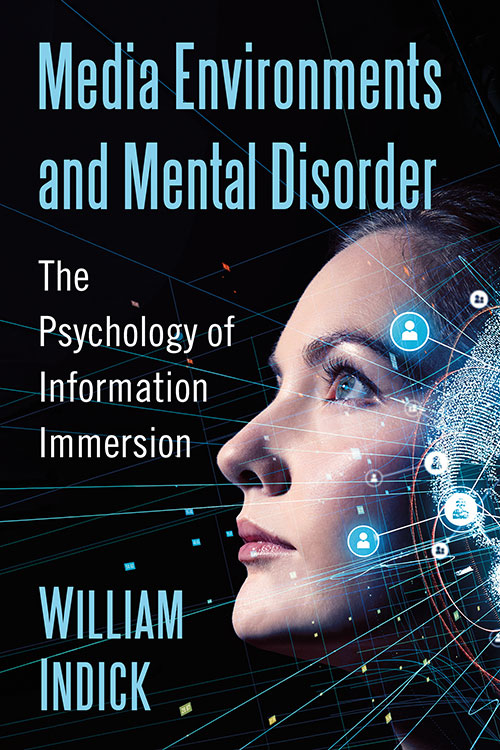Media Environments and Mental Disorder
The Psychology of Information Immersion
Original price was: $55.00.$14.99Current price is: $14.99.
In stock
About the Book
The information environments that modern society requires us to master and engage in are based in literacy and digital communication. Mediated information not only passes through our brains, it alters and rewires them. Since our environment, to a large extent, is shaped by the way we perceive, understand, and communicate information, we can even think of mental disorders as symptoms of maladaptation to our media environments. This book uses this “media ecology” model to explore the effects of media on mental disorders. It traces the development of media from the most basic forms–the sights and sounds expressed by the human body–to the most technologically complex media created to date, showing how each medium of communication relates to specific mental disorders such as anxiety, depression, schizophrenia, and autism. As the digital age proceeds to envelop us in an environment of infinite and instantly accessible information, it’s crucial to our own mental health to understand how the various forms of media influence and shape our minds and behaviors.
About the Author(s)
Bibliographic Details
William Indick
Format: softcover (6 x 9)
Pages: 300
Bibliographic Info: notes, bibliography, index
Copyright Date: 2021
pISBN: 978-1-4766-7882-5
eISBN: 978-1-4766-4251-2
Imprint: McFarland
Table of Contents
Preface: Victims of Sight, Victims of Sound 1
Introduction: The Hall of Mirrors 5
Every Medium Is a Mirror 11
One. A Media Ecology Model of Mental Illness 13
The Demonology Model 14
Somatogenesis 15
Psychogenesis 16
Psychoanalysis 17
The Medical Model 18
The Mechanical Model 21
The Clinical Model 24
The Neurochemical Model 26
The Spectrum Model 29
Neurological Diversity 31
The Vulnerability/Stress Model 33
The Media Ecology Model 35
Two. Language, Literacy and the Leftward Shift 37
Language and Lateralization 39
Oral Language and Linearity 43
Literacy and Linearity 46
Cognitive Distance 48
Print 54
Electronic Media and Digital Media 56
The Forest of Mirrors 60
Cerebral Dominance and the Sickle Cell 61
The Hemispheric Dominance Model of Mental Disorder 64
Three. Autism and the Inhibited Mind 68
Autism as the Endpoint of the Leftward Shift 72
The Displacement Effect 74
Autism: Epidemic or Epiphenomenon? 78
Genetic Causation of Autism 81
Intellectualism and Autism 82
Weak Central Coherence 86
Intense World Syndrome 91
Theory of Mind 93
Language Deficits 96
“Autistic Intelligence” 99
“Homo Aspergerus” and “Geek Chic” 102
Digital Reflections of the Autistic Self 106
Four. Schizophrenia, Dual Consciousness and the Split Mind 109
Schizophrenia as an Aspect of Human Nature 111
Schizophrenia as a Byproduct of Language 113
Spectra within Spectra 119
Schizophrenic Thinking and Pollyannaism 121
Madness, Genius and Eccentricity 124
Literacy and Thought Disorder 127
Literacy and Duality 128
The Haunted Unconscious 129
Hyperconscious Self-Reflection and Alienation 133
Westernization 138
Fragmentation, Intellectualization and Alienation 141
Fragmentation, Electronification and Digitization 147
The Digital Stranger 152
Five. Anxious Depression: The Consequences of Consciousness 154
The Pendulum Metaphor 157
How Melancholia Became Anxiety and Depression 161
Adaptive and Maladaptive Anxiety 163
Anxiety to the Left of Me, Depression to the Right 169
Ineffective Therapies: The Emperor’s New and Old Clothes 171
The Optimist and the Pessimist Within 174
The Brain’s “Default Mode Network” 177
The Tyranny of the Anxious 179
Six. Disordered Learning and Neurological Intolerance 185
ADHD 186
Decontextualized Learning 188
The Classroom: A Toxic Media Environment 189
Literacy and Education: A Brief and Brutal History 196
Specialism versus Generalism 199
Age Segregation and Specialism vs. Age Integration and Generalism 203
Manufacturing Anxiety in Schools 206
Dyslexia 210
Dyscalculia 214
The Gift of Dyslexia? 219
Literacy in the Digital Age 223
The Future of Literacy 224
The Musical Literacy Metaphor 232
The Teacher as Artist 234
The Classroom of the Future 236
Seven. Social Media: Narcissus Lost in the Hall of Mirrors 240
The Self as Object 246
Kohut’s Mirror Model of Narcissism 250
“The Age of Narcissism” 253
The Soul Photograph 254
The Old Gods and the New 256
Celebrity Worship and the Social Media Mirror 258
Ouroboros and Erysichton 261
Wounded Narcissism and the Many-Faced God in the Magic Mirror 263
Locked in to the Double Bind 266
“The Global Village” 269
Conclusion: Media Mindfulness 275
Chapter Notes 277
Bibliography 283
Index 289






